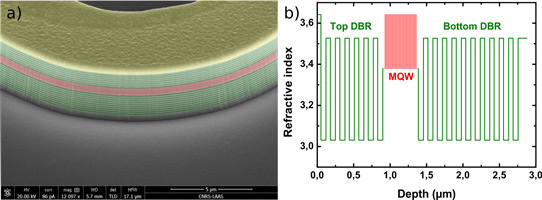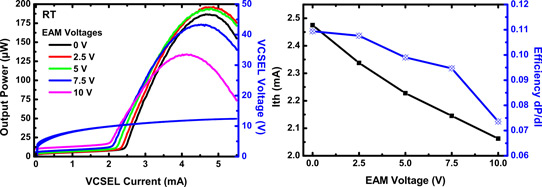- News
18 April 2018
Electro-absorption modulators for vertical-cavity surface-emitting lasers
Researchers from Université de Toulouse in France and Vrije Universiteit Brussel in Belgium have developed vertical electro-absorption modulators (EAMs) for use with vertical-cavity surface-emitting lasers (VCSELs) [L Marigo-Lombart et al, J. Phys. D: Appl. Phys., vol51, p145101, 2018]. Such devices are desired for optical communications, signal processing and 3D imaging.
VCSELs can be modulated by modulating the current injection, but there are speed limits related to how fast the carriers can recombine, leading to delays in output response. The researchers hope that faster signaling may be achieved with separate modulator structures.

Figure 1: (a) Scanning electron micrograph of EAM with 10-period bottom DBR, 25 quantum wells and 6-period top DBR. (b) Refractive index of EAM structure as a function of depth.
The EAM structures consisted of quarter-wavelength pairs of aluminium gallium arsenide (Al0.9Ga0.1As/Al0.15Ga0.85As) forming distributed Bragg reflectors (DBRs) around GaAs multiple quantum wells (MQWs) in Al0.3Ga0.7As digital alloy barriers (Figure 1). The DBRs create a Fabry-Perot cavity. The EAM is effected through an electric field that changes the overlap between the Fabry-Perot resonance and exciton absorption of photons in the MQW.
After testing and analyzing separate EAM structures, the team built an EAM-VCSEL combination. The epitaxial material was grown by molecular beam epitaxy (MBE) on n-GaAs substrate: 35-pairs of quarter-wavelength Al0.9Ga0.1As/Al0.15Ga0.85As VCSEL DBRs, a wavelength cavity with three GaAs QWs, 30nm Al0.98Ga0.02As for lateral oxidation confinement, a p-doped 22-period shared DBR, a 25-period EAM MQW, and a doped 6-period top EAM DBR. The middle DBR also included a ¾-wavelength layer for a ground contact.

Figure 2: (a) Output power-current-voltage curves of EAM-VCSEL for different EAM voltages. (b) Evolution of VCSEL threshold and efficiency.
The operating voltage of the device was rather high, and the output power low, due to the less than 1μm-diameter oxide aperture (Figure 2). Also, there was temperature degradation of performance. With 5.5mA VCSEL injection and a 5V EAM bias, the output power was 172μW. The power fell by 57% to 73.5μW for a 10V EAM bias.
A higher modulation depth of 68% was achieved with 2.5mA injection (near threshold) with the output power increasing from 17.2μW at 0V bias to 54.5μW at 7.5V. The 5.5mA injection therefore gave 11.4%/V modulation and 2.5mA gave 9%/V.
Vertical electro-absorption modulators VCSELs GaAs AlGaAs GaAs substrates MBE
https://doi.org/10.1088/1361-6463/aab1dc
The author Mike Cooke is a freelance technology journalist who has worked in the semiconductor and advanced technology sectors since 1997.


